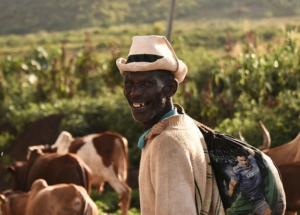3 Organizations Combating Poverty in Sub-Saharan Africa
 The region of sub-Saharan Africa encompasses an aggregate of nations with diverse geographies, histories and cultures. Furthermore, the countries composing sub-Saharan Africa have diverse needs. From unaffordable health care to regional conflict, the issues besetting sub-Saharan Africa have left many of its inhabitants in poverty. Fortunately, philanthropic organizations have stepped up to the plate to remedy the many challenges affecting sub-Saharan Africa. Three organizations, in particular, have shown that there is not a universal methodology for combating poverty in sub-Saharan Africa.
The region of sub-Saharan Africa encompasses an aggregate of nations with diverse geographies, histories and cultures. Furthermore, the countries composing sub-Saharan Africa have diverse needs. From unaffordable health care to regional conflict, the issues besetting sub-Saharan Africa have left many of its inhabitants in poverty. Fortunately, philanthropic organizations have stepped up to the plate to remedy the many challenges affecting sub-Saharan Africa. Three organizations, in particular, have shown that there is not a universal methodology for combating poverty in sub-Saharan Africa.
Poverty in Sub-Saharan Africa
According to the World Bank, in 2017, two-thirds of the “global extreme poor population” lived in sub-Saharan Africa. While poverty is actually slowly declining in the region, a rapid rise in population growth is stalling a reduction in the number of impoverished people in sub-Saharan Africa.
However, there are differences among sub-Saharan Africa’s constituent countries. According to the World Bank’s 2018 data, in the Democratic Republic of Congo, 73% of people lived on less than $1.90 per day, the international poverty line. Additionally, the World Bank predicted that 27% of Ethiopians lived below the international poverty line in 2019. Finally, a 2020 U.N. report indicates that 18.9% of South Africans live on less than $1.90 a day.
Agrarian Communities “Grow Together” with Nanmo
Nanmo is an Arabic word meaning “growing together.” This word is the spirit of the partnership between the Bill & Melinda Gates Foundation and the Qatar Fund for Development’s $200 million investment in sub-Saharan Africa.
Nanmo’s goal is to provide adaptive ways for rural farmers, especially women, to respond to climate-related difficulties. Mark Suzman, CEO of the Gates Foundation, told the Gulf Times that a “Majority of the poorest living in sub-Saharan Africa are the rural folk. They depend on agriculture…in parts of the world that are seeing much greater temperature fluctuation with frequent floods or frequent droughts.” The collaborative organization gives agrarian communities innovative technologies that can bolster their pathway to food security.
Suzman said that Nanmo was not confined to one country. However, a pilot program in Nigeria and Ethiopia showed an auspicious sign for the future of Nanmo in combating poverty in sub-Saharan Africa.
Efficiency for Access: Ameliorating Poverty through Clean Energy Solutions
In sub-Saharan Africa, more than 600 million people lack a connection to their country’s energy grid. Efficiency for Access, a coalition coordinated by CLASP and Energy Saving Trust, is working to bring life-changing, clean-energy appliances to vulnerable communities.
Bridging the gap between those on and off the energy grid could lead to improved agricultural productivity and thus poverty alleviation. Mike Maina from CLASP told FairPlanet that “In sub-Saharan Africa, 60% to 70% of the population is involved in agricultural livelihoods with the least mechanization in the world. This is a region where using renewable energy can have a big impact, especially on low-income populations.”
In addition to agricultural appliances like solar water pumps, Efficiency for Access also supplies products such as solar-powered refrigerators, electric pressure cookers and fans. As CLASP conveyed to FairPlanet, its theory is to provide people with a livelihood and not just a light bulb.
Zoetis Provides Veterinary Care to Farmers’ Livestock
Despite sub-Saharan Africa’s sizable livestock population, it has the “lowest productivity per animal” of any region. According to Poultry World, Zoetis, an animal health company, is improving the health of livestock through its A.L.P.H.A. initiative. Inaugurated in 2017, this program provides accessible veterinary services to farmers across the region.
Throughout its five years in operation, Zoetis has worked with 128 million animals and educated 26,000 individuals, according to Poultry World. By supplying inoculations and medical training to communities in sub-Saharan Africa, the African Livestock Health and Productivity Advancement program has been a boon for food security in sub-Saharan Africa.
Zoetis’s activity in the region has enabled African communities to produce safer food while reducing the economic burden of raising livestock. Thus, the A.L.P.H.A. initiative has been successfully combating poverty in sub-Saharan Africa.
A Glimpse into the Region’s Future
These three organizations are just some of the numerous charitable entities working on combating poverty in sub-Saharan Africa. While these organizations exemplify a propitious future for the region, it still requires more work.
Governments and NGOs alike need to work in harmony to ensure that the region’s sundry needs are met. However, these three organizations demonstrate that there is no “one size fits all” approach to combating poverty in sub-Saharan Africa. Despite the need for more concerted and adaptable action on behalf of the world’s poor, these three organizations provide a bright glimpse into the future for sub-Saharan Africa.
– Alexander Portner
Photo: Flickr
